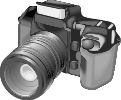For many people, the complexities of digital imaging technology make digital cameras less appealing than their film counterparts. Confusing technical jargon make an informed purchase decision very awkward and difficult. Moreover, getting relevant help is often problematic, especially in department and wholesale stores, where sales staff aren’t qualified or educated enough to provide relevant or adequate information.
The selection of a digital camera, however, can be quite painless and relatively simple if the buyer is prepared with the right information. Knowing a little about how a digital camera works will empower a buyer to find the right camera within their budget.
From the exterior, a digital camera is the the same as any other camera. It has lenses, a flash, view finder and shutter button. Within the interior, however, they are very different creatures. Reflected light passes through the lens and past the shutter onto an electronic sensor that converts the light into various electrical charges, which are then interpreted and converted into digital information.
These electronic sensors come in two flavors: CCD and CMOS. CCD sensors are very mature and deliver superior digital quality. Unfortunately, CCD sensors are very costly to produce and consume many times the power of the cheaper CMOS alternatives. As a result, CCD sensors are frequently found in digital SLRs (full size), while CMOS sensors are more common in smaller, point-n-shoot cameras (miniatures).
Once interpreted by the sensor, the photo manifests itself in digital form as a series of pixels – single points in an image. These tiny colored “dots” are closely arranged in a rectangular area composed of rows and columns that ultimately form an image.
The actual dimensions of the image (measured in pixels) are often referred to as it’s resolution. The higher the resolution, the greater detail the image will contain. Often, resolutions are listed by width by height. For example, a resolution of 1216×912 means the image is 1,216 pixels wide and 912 pixels tall.
A camera’s maximum resolution is often displayed in megapixels. A megapixel is simply the total amount of pixels (an approximation, in millions) an image contains. For example, an image with a resolution of 1216×912 has a rating of one megapixel (approximately one million pixels).
A five megapixel camera, for example, will generate an image that contains approximately five million pixels. The more pixels that can be used to describe the picture, the finer the image will be. A six megapixel image, for example, has approximately a million more pixels than a five megapixel image, making it an overall finer image. In other words, the higher the megapixel, the higher the resolution.
Megapixel, however, isn’t a true measure of a camera’s quality. For example, a four megapixel camera with high-quality lenses may produce better images than a five megapixel camera with cheap lenses. In contrast, using high-quality film in a cheap camera doesn’t necessarily result in high-quality images. Think of megapixel as the “image capture capacity” of a digital camera.
Once the image has been interpreted by the image sensor, and converted into digital information (pixels), it is processed (converted to a particular file type, such as RAW, JPEG or TIFF) and then saved onto the camera card (Compact Flash, SD, MMC, Memory Stick, etc). The image can later be deleted, downloaded to the computer or taken to an image processing facility for printing. Later, once the photos have been downloaded or printed, the card is erased and reused.
Digital cameras have undergone a dramatic step forward in their technological evolution, and have found acceptance among millions of people world wide. The technology will continue to grow and develop as more people adopt it. They are a major player in this digital era.
Have comments or suggestions for a weekly Tech Tips article? Send an email to webmaster@sunad.com.
Understanding Digital Cameras, Part II

